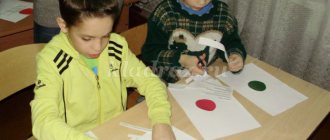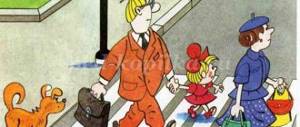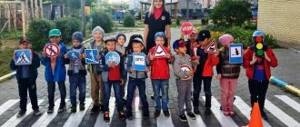The importance of drawings on the topic of traffic rules for children
Many parents today alternate between pedestrians and drivers. Thus, the baby can learn from adults from a very early period. Walking along the streets, the child pays attention to the pedestrian crossing, its sign, and gradually learns other information. Subsequently, it will be easier for him to draw a drawing of traffic rules in kindergarten.
Project on traffic rules “Jolly traffic light”
Important! Many modern cartoons (“Smeshariki”, “Robocar Poli”, “Lessons from Aunt Owl”) deal in great detail with the issues of children’s behavior on the roads. The animated series “Three Cats” also provides explanations, which makes viewing not only entertaining, but also educational.
To help your child remember traffic rules faster, you can:
- Cards with traffic rules,
- Draw on your own or using an illustration template using pencil, paints, watercolors,
- When drawing, use special coloring books or stencils, which can be bought in children's stores or printed from the Internet.
The sooner a child learns the names of signs and their characteristics, the safer his time on the street will be.
Children learning traffic lights
The importance of crafts on the topic of traffic rules
Despite the fact that children daily participate in traffic together with adults (crossing the road or riding in vehicles), the topic of traffic rules is unfamiliar to them and they are the most vulnerable part of the population to road accidents.
Therefore, creating crafts on the topic of traffic rules for school or kindergarten has become part of the requirements of modern educational institutions.
Composition from plasticine
As practice shows, teaching children to cross the road competently and use pedestrian crossings and zebra crossings is not at all difficult. Kids quickly grasp new information presented in a creative form.
In turn, playful moments give lessons a direct character: DIY road safety crafts allow children to quickly remember how to behave on the roads.
Drawing and traffic rules
The goals pursued in kindergarten when creating a children's drawing on the topic of traffic rules:
- Educational. They include expanding and consolidating children’s knowledge about traffic lights, traffic controller hand signals, traffic patterns in summer and winter, and other traffic regulations.
- Familiarity with signs on the roads: directional, prohibitory, service and warning signs.
- A story about the culture of behavior on the roads.
- Educational. Teach the desire to follow the rules, take care of your health, be responsive and come to the rescue.
Studying road signs
The following materials are required for a drawing lesson at a preschool educational institution:
- Layouts and pictures of traffic lights, road signs, streets. Can be replaced with sets from specialized stores.
- Sheets of paper or albums.
- Gouache, watercolors or paints, colored pencils or a simple regular pencil.
- In some cases, the learning process takes place on the faces of the kindergarten, then multi-colored crayons are required. As a rule, such events are held in the spring or autumn when children are playing on the street.
- Didactic games, such as “Collect signs”, “What does this mean?”, “Good - bad?”, related to traffic rules.
Additional Information! Classes are held in a playful way. First, children are invited to play a game, repeat gestures after the teacher, walk in place, and answer questions. At the end of the lesson, as a test of acquired knowledge, the kids are asked to draw what they remember. Or copy the signs from the sample.
Interesting layout ideas
The main idea of creating the layout is to attract the attention of young participants to safety issues on the streets and in yards. If you introduce kids to a boring story about danger and correct behavior, not a single child will understand the full essence of what is happening. Only visual action in which children are involved can attract and interest.
Layouts can be:
- horizontal;
- corner;
- vertical.
Horizontal Layouts
Horizontal models are built in one plane; three-dimensional figures of cars, people, trees and houses are placed on them. To simulate road transport, you can use toy cars of a suitable size, or you can use templates from the Internet that you just need to print. The youngest students will not yet be able to carefully glue car patterns, but children from the middle or older group can do this.
Cognitive development of younger and older preschoolers
Additional Information! Children from younger groups can easily cover cardboard boxes of juice or medicine with colored paper, which, with the help of a teacher, can be turned into houses.
Milk carton houses
Painting over the background for traffic rules will be too tedious for children; during this activity they will forget the main idea of the work. Therefore, it is easier to paint road surfaces and lawns using a spray can. This background will dry quickly and will lift the spirits of all participants in the process. In order for the paint to hit the target exactly, it is worth using masking tape, which will protect the joints of two zones of different colors.
Small toys can act as pedestrians. If the process of creating a model does not involve the use of ready-made toys, passers-by can be sculpted from plasticine. It is convenient to make road markings from self-adhesive white stripes - it is so easy to create an even line of the side of the road and a zebra crossing.
Horizontal layouts are good because they can be made quite large and used as an intellectual center for playing traffic rules. The children will be happy to drive cars and help pedestrians cross the road. The main idea of such a game is to simulate real traffic situations, develop speech and imagination.
Corner Layouts
This type of layout is designed to demonstrate different modes of transport, in combination with the environment. Corner layouts are created in two planes: horizontal and vertical, connected at right angles. When preparing a layout of traffic regulations for a kindergarten with your own hands, you can use air transport templates to attach a flying plane or helicopter to a vertically located plane.
This type of layout has its advantages - it can easily accommodate a vehicle flying in the sky, which on a horizontal layout will only be present on the runway, awaiting takeoff.
Interesting! If you attach aircraft to the model using a spring taken from an automatic ballpoint pen, you will get a dynamic effect - the plane or helicopter will move in the air.
It is important to use a familiar fragment of the street that children see every time they go to kindergarten:
- a familiar intersection;
- a store located nearby;
- hospital;
- school next door.
Children who see the model before their eyes every day in a group will know exactly how to behave on the streets in the vicinity of the kindergarten.
Vertical layout
Such layouts look like voluminous posters and do not imply further use in games, however, they also have their educational function - they are convenient for depicting private road situations, accompanied by a written set of rules. Volume can be given to such mock-up posters by gluing sheets of foam plastic, cut to the shape of the contour of the selected fragment, and decorated accordingly, over individual objects.
Vertical layout
Road safety through the eyes of children
For several years, the kindergarten has been carrying out planned, systematic work to develop conscious behavior on the roads in children. Traffic rules training is a vital necessity today, which is why any activities related to this issue are always supported.
Evaluating drawings on road safety through the eyes of children, the world community came to the conclusion that a child sees the road differently and crosses it differently. That is why it is important to be careful that children know the traffic rules. An adult can always study the road situation in advance, and children, as a rule, only when they are on the roadway.
Illustration of how children see road safety
Note! Child psychology is different in that the child’s attention is selective. Therefore, they cannot keep their focus on more than two objects. For this reason, from all the diversity of the surrounding world, he singles out exactly what attracts him, arousing curiosity. Therefore, if the ball jumps out onto the road, the child may rush after it, completely unaware that it is dangerous there.
Classes on cognitive development in the middle group of preschool educational institutions
How children of different ages perceive the road:
- 3-5 years. The child distinguishes moving vehicles from stationary ones. He believes the car can stop abruptly, like a toy that turns off instantly when a button is pressed. Of course, he is not able to estimate the speed and braking distance.
- 5-6 years. The child’s lateral vision is already two-thirds developed, and his senses work more actively. But so far he does not know how to distribute his attention.
- 7 years. The child knows how to navigate where the right side is and where the left side is.
- 9 years. The child has road skills. He can master a bicycle, react to sound, and measure the size of an object with its distance.
- 10 years. Only by this age is the nervous system fully formed. The child, seeing the danger, freezes in place and closes his eyes in fear. In this context, the child’s subconscious acts according to the principle: “Since I don’t see any danger, it simply doesn’t exist, and everything is fine with me.”
Crossword puzzles on traffic rules in kindergarten
A crossword puzzle on the topic of traffic rules is a kind of labyrinth in which you need to place the right words to find your way. In preschool educational institutions, you can use a crossword puzzle on traffic rules to teach children. This is one of the most effective methods. When composing a crossword puzzle, you need to make sure that it is short and contains questions that are easy to answer:
- What kind of animal does the pedestrian path look like? (zebra);
- He has a staff and a whistle. He controls the movement. Who is this? (Adjuster);
- A small piece of paper, without which you cannot travel on a bus or tram. What is this? (ticket);
- To cross the river, you need to go through... (bridge);
- Where should your hand point first to cross the road? (left);
- Here is a long passage, but who is walking along it? (a pedestrian);
- Who can ride on two wheels? (cyclist).
- Red, yellow, green…. traffic light. What word is missing? (light);
Traffic crossword
Important! The teacher can create a crossword puzzle for kindergarten students on his own. To do this, a main horizontal column is created, intersected by several vertical word lines. In the last year, every child should learn to solve simple logic problems. Using the template, you can create a large number of interesting crossword puzzles.
Formation of CGN and self-care skills in young children
Competitions in preschool educational institutions
The preschool educational institution annually holds competitions “Traffic rules through the eyes of children, drawings”, the participants of which are kindergarten students.
The objectives of the events are:
- Promotion of competent behavior on roadways,
- Development of creative skills when getting acquainted with traffic rules,
- Development of artistic and aesthetic tastes,
- Identification of talents,
- Development of imagination in creativity,
- Analysis of the state of safety corners in groups,
- Strengthening the role of adults in teaching children traffic rules.
Competition-exhibition of drawings by preschoolers in kindergarten
The stages of the competition are as follows:
- Preparatory. Here parents and children are introduced to the rules and goals of the event.
- Practical. Compliance with regulations - drawing pictures on a given topic.
- Final. Summarizing. If possible, presentation of diplomas and prizes.
Additional Information! The competition is held in accordance with a table where marks are given for the fulfillment of each criterion: correct design of the sign, safety rules.
How to teach a child to solve traffic rules puzzles
Puzzles on traffic rules for teaching preschoolers the rules of the road are simple, but it is extremely important to make sure that the preschooler understands the essence of solving them. When entering the primary grade of school, a question about puzzles may be asked, and the child must demonstrate his ability to solve the simplest riddles. To teach your child to solve puzzles, you need the following:
- For convenience, it is recommended to print out the rebus and distribute it to everyone in the group, or hang a large poster on the board where all the symbols are clearly visible.
- Then comes the preparatory stage - the teacher solves several puzzles, while explaining each of his actions.
- Children aged 6-7 years should learn to subtract the first or last letter from a word to get the correct answer. To make this easier, first all answers are written down, and the teacher crosses out the letters on paper.
- Then the children try to solve the puzzles on their own, and the teacher gives hints.
Additional Information! You also need to explain to the child that if the picture is shown upside down, then you need to read the word the other way around, for example: paw = apal. In this case, the first or last letter can additionally be crossed out.
How to draw a drawing according to traffic rules yourself with a child
Knowing the rules, not just the rules of the road, makes life much easier for both parents and children.
Teaching traffic rules at home is best done in a playful way:
- Play scenes
- Draw posters or illustrations, wall newspapers
- Color the finished pictures.
Wall newspaper “Play without violations”
Children remember such lessons extremely quickly and learn a lot of useful knowledge from them. Even kids can know exactly how to avoid an accident on the road in just a couple of lessons.
Additional Information! If it is possible to place the baby’s drawing in a frame, then you should do so. This will help him see the rule before his eyes many times. In addition, the child will enjoy the process of attention to his work, which will help motivate him for subsequent learning.
To create posters you will need:
- Sheet A4. It is better to take whatman paper, since you can depict much more details on it.
- Glue.
- Scissors.
- Colored paper.
- If desired, felt-tip pens and pencils - for writing down rules and drawing small details.
First you need to find a sample or come up with yourself what exactly you would like to depict. Draw the intended picture on a piece of whatman paper. You can also cut out small pieces and parts from colored paper and glue them onto the main background.
The poster can be signed with short slogans:
- “You can’t play on the road!”
- “Be careful on the road - this is a dangerous zone!”,
- "Children! It’s forbidden to fool around on the road!”
- “I know the traffic rules well, and you?”
How to teach a child attentiveness and perseverance at 7 years old
Whatman paper should depict a safe world as children see it. Suitable pictures for this purpose:
- People who cross the road
- Cars that are stopped at traffic lights
- Zebra - pedestrian crossing,
- Railroad crossing,
- Travel by public transport.
Materials for making models
The most common material for creating educational layouts is cardboard. Its density is sufficient to withstand children's play and an active form of cognition. Sometimes sheets of plywood or fiberboard are chosen as the base.
Games for developing memory and attention in children
Be sure to have sheets of paper: both colored and white stationery. To fix sheets to other materials or to each other, use a glue stick or PVA glue.
Important! If you don’t have colored paper or spray paint, you can use watercolor or gouache, which gives the desired shade to the white sheets. But in this case, start working on the layout correctly by coloring the paper - while it dries, you can prepare other details.
To create buildings and stops, it is convenient to take boxes of tea, juice or milk. If the packages are so smooth that the glue does not securely attach the colored paper to the frame, you can use a stapler.
It is convenient to use Lego men or representatives of fairy-tale characters from chocolate eggs with a surprise as pedestrians. Their sizes will be harmonious on the layout, and also make them quite stable, which allows such pedestrians to stand in front of the crossing, waiting for their traffic light signal.
To make traffic signs that are easy to move, you will need:
- coins;
- plasticine;
- sticks left over from eaten ice cream, or similar new ones;
- paper;
- glue;
- scissors;
- markers (or printed images).
How to make road signs quickly and easily - step-by-step master class:
- The coins are wrapped in plasticine, which creates the base weight for the road sign.
- It is easy to attach the stick to the base by drowning it in plasticine.
3. The images of road signs printed in duplicate will be cut out with scissors and pasted onto the support on both sides.
Road signs to start with
Learning road signs is not an easy task for children. Therefore, the emphasis should be on the most necessary things that the child can use. Practical application will increase the importance of learning in the eyes of the baby, he will be interested. The signs with which it is useful to begin studying most often include the following:
Crosswalk
Directly indicates the place where it is permitted to cross the road. The most necessary sign for a pedestrian, the child will remember it and will be able to show him on a walk where the zebra is. It must be distinguished from a “twin” from another group.
Crosswalk
It belongs to a group of warning signs and means that a zebra crossing is located soon in the direction of travel. Kids sometimes confuse it with the previous sign, seeing the same black man on a white background, but you can’t cross the road here.
Underground pedestrian crossing
You can get to the other side of the road by going underground. But you need to go down only if there is such a sign before the descent.
Children
A sign for the driver - warns him that children may appear in this place. They are installed near children's educational institutions, so you can always show it to kids during a short walk. It is important that kids learn that running here, as in any other place where cars are driving, is not allowed.
Classes on traffic rules in preparatory groups of kindergartens
Focusing on it, the baby will confidently determine where to wait for passenger transport to go home or on business with his parents.
the main road
Gives the driver an advantage when driving at an intersection where there is no traffic light. It should be studied so that thematic games related to driving through an impromptu intersection according to the rules are available. And this is an introduction to the key idea that real motorists follow the rules.
Signals that you will need to give way at the intersection. It is a “companion” of the previous sign; without it it is difficult to play crossroads.








